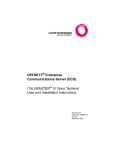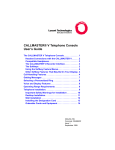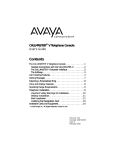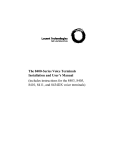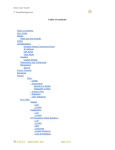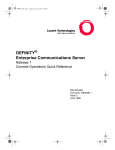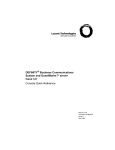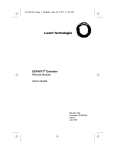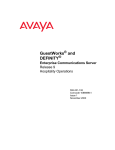Download AT&T Definity Callmaster III User`s manual
Transcript
015162_cover_new.fm Page 1 Sunday, November 26, 2000 12:46 PM CALLMASTER® VI Voice Terminal Version 1.0 Installation and User’s Manual Caution: Please DO NOT DISCARD this booklet. It contains important safety information necessary for anyone responsible for installing or using these terminals. 555-015-162 Comcode 107969602 Issue 1 June, 1997 015162_cover_new.fm Page 2 Sunday, November 26, 2000 12:46 PM WARRANTY All terms and conditions specified in the owner’s agreement with Avaya apply. NOTICE While reasonable efforts were made to ensure that the information in this document was complete and accurate at the time of printing, Lucent Technologies can assume no responsibility for any errors. Changes or corrections to the information contained in this document may be incorporated into future issues. DISCLAIMER Intellectual property related to this product (including trademarks) and registered to AT&T Corporation has been transferred to Lucent Technologies Incorporated. Any references within this text to American Telephone and Telegraph Corporation or AT&T should be interpreted as references to Lucent Technologies Incorporated. The exception is cross-references to books published prior to December 31, 1996, which retain their original AT&T titles. Intellectual property related to this product (including trademarks) and registered to Lucent Technologies Inc. has been transferred or licensed to Avaya Inc. Any reference within the text to Lucent Technologies Inc. or Lucent should be interpreted as references to Avaya Inc. The exception is cross references to books published prior to April 1, 2001, which may retain their original Lucent titles. Avaya Inc. formed as a result of Lucent’s planned restructuring, designs builds and delivers voice, converged voice and data, customer relationship management, messaging, multi-service networking and structured cabling products and services. Avaya Labs is the research and development arm for the company. THE “CE” MARK The “CE” mark affixed to this equipment means that it conforms to the European Union Electromagnetic Compatibility Directive (89/336/EEC) and the Low Voltage Directive (73/23/EEC). HEARING AID COMPATIBILITY These voice terminals are Hearing-Aid Compatible (“HAC”) when used with HAC headsets. TRADEMARKS CALLMASTER and DEFINITY are registered trademarks of Lucent Technologies. STARSET, SUPRA, and MIRAGE are registered trademarks of Plantronics, Inc. TRISTAR and ENCORE are trademarks of Plantronics, Inc. Developed by Lucent Technologies Network Systems Customer Training and Information Products ©1997 Avaya Inc. All Rights Reserved Printed in USA Printed in USA INTERFERENCE WARNING INFORMATION WARNING: This equipment has been tested and found to comply with the limits for a Class B digital device, pursuant to Part 15 of the FCC Rules and CISPR-22. These limits are designed to provide reasonable protection against harmful interference in an installation. This equipment generates, uses, and can radiate radio frequency energy and, if not installed and used in accordance with the instructions, may cause harmful interference to radio and television communications. However, there is no guarantee that interference will not occur in a particular installation. If this equipment does cause harmful interference to radio or television reception, which can be determined by turning the equipment off and on, the user is encouraged to try to correct the interference by one or more of the following measures: ● Reorient or relocate the receiving antennae. ● Increase the separation between the equipment and receiver. ● Plug the equipment into an outlet on a circuit different from that to which the receiver is connected. ● Consult the dealer or an experienced radio/tv technician for help. ENVIRONMENTAL INFORMATION In accordance with international environmental standards, parts of this Lucent Technologies voice terminal have been manufactured with recyclable plastic resins. These telephone parts have been marked >ABS< so they can be easily identified at recycling or waste recovery facilities when appropriate. The paper used in this documentation is also recyclable. 14 IMPORTANT USER SAFETY INSTRUCTIONS Message Waiting Indicator One red LED in the center of the CALLMASTER VI serves as a Message Waiting indicator. The lamp lights when a message is waiting. Note: if this lamp flashes it is an indication that the DEFINITY ECS is not communicating with the CALLMASTER VI. Careful attention has been devoted to quality standards in the manufacture of your new voice terminal. Safety is a major factor in the design of every set. But, safety is YOUR responsibility, also. Please read the following helpful tips. These suggestions will enable you to take full advantage of your new voice terminal. Then, retain these tips for later use. Call Appearance Buttons These two call appearance buttons have two lamps each. The green lamp indicates that the line is in use, while the red lamp indicates that there are no calls on the line at the present time. CAUTION: This voice terminal is NOT for residential use. It is for business systems applications ONLY. Use in a residential environment could result in an electrical short circuit when the telephone wiring is set up to provide other applications, for example, for appliance control or power transformers. The AC power used in these applications may create a safety hazard by placing a direct short circuit across the telephone wiring. These buttons are administrable. One suggestion is to configure them as Send All Calls or Call Forwarding buttons for use when the PC goes down. Release Button The large blue button has no indicator. Pressing the Release button clears the current call. This button is administerable, but it is recommended that it be assigned to the Release function. USE When using your telephone equipment, the following safety precautions should always be followed to reduce the risk of fire, electric shock, and injury to persons. ● Read and understand all instructions. ● Follow all warnings and instructions marked on the telephone. ● 12 This telephone can be hazardous if immersed in water. To avoid the possibility of electric shock, do not use it while you are wet. If you accidentally drop the telephone into water, do not retrieve it until you have first unplugged the line cord from the modular jack and the EIA/TIA cable from your personal computer. Then, call service personnel to ask about a replacement. ● Avoid using the telephone during electrical storms in your immediate area. There is a risk of electric shock from lightning. Urgent calls should be brief. Even though protective measures may have been installed to limit electrical surges from entering your business, absolute protection from lightning is impossible. ● If you suspect a natural gas leak, report it immediately, but use a telephone away from the area in question. The telephone’s electrical contacts could generate a tiny spark. While unlikely, it is possible that this spark could ignite heavy concentrations of gas. ● ● Never push objects of any kind into the equipment through housing slots since they may touch hazardous voltage points or short out parts that could result in a risk of electric shock. Never spill liquid of any kind on the telephone. If liquid is spilled, however, refer servicing to proper service personnel. To reduce the risk of electric shock, do not disassemble this telephone. There are no user serviceable parts. Opening or removing covers may expose you to hazardous voltages. Incorrect reassembly can cause electric shock when the telephone is subsequently used. SERVICE 1. Before cleaning, unplug the telephone from the modular wall jack and your personal computer. Do not use liquid cleaners or aerosol cleaners. Use a damp cloth for cleaning. 2. Unplug the telephone from the modular wall jack. Be sure to refer servicing to qualified service personnel when these conditions exist: The CALLMASTER VI can be administered with many features that are accessible only from your PC. Careful consideration of which features are assigned to these buttons will make your CALLMASTER VI more useful when your PC is not available. Note: One possibility is to administer these buttons as abbr-dial numbers for use when the PC is not available to provide dialing. Headset On/Off Button The CALLMASTER VI does not have a physical switchhook or an integrated handset cradle. Instead, you press the Headset On/Off button to toggle between the on-hook condition and the off-hook condition. On the CALLMASTER III, plugging the headset into the jack puts the CALLMASTER III off-hook. Unlike the CALLMASTER III, plugging the headset into the CALLMASTER VI does not affect the headset On/Off function. You can remove your headset without toggling the on-hook/ off-hook condition. ● If liquid has been spilled into the telephone ● If the telephone has been exposed to rain or water The red status indicator associated with the Mute button serves as an indicator for the Headset On/Off function. When the CALLMASTER VI is first powered up, and after a reset, the headset is in the on-hook condition. When the headset is on-hook, the status indicator is red, meaning the voice path to the headset is turned off. ● If the telephone has been dropped or the housing has been damaged When the headset is off-hook, the status indicator is dark, and the voice path to the headset is fully functional. ● If you note a distinct change in the performance of the telephone. This button is not administerable. Mute Button SAVE THESE INSTRUCTIONS When you see this warning symbol on the product, refer to the instructions booklet (packed with the product) for more information before proceeding. The purpose of the Mute function is to electronically disconnect the microphone so that the caller cannot hear you if you want to speak to someone else in the room. Use the Mute button to toggle the mute function on and off. When the voice terminal is muted, the red status indicator is flashing on for 50 ms, and then off for 200 ms. NOTE: Going on-hook ends mute, so the lamp will go from flashing to steady on. This button is not administerable. 11 Using the Buttons The CALLMASTER VI has eight buttons and eight indicators (see Figure 6). The voice terminal arrives with some of the buttons—Log In, Headset On/Off, Mute, Call Appearance 1, Call Appearance 2, and Release—already configured with button assignments. The buttons and indicators are described in this section. IMPORTANT SAFETY WARNINGS FOR INSTALLATION When this product is located in a separate building from the telephone communications system, a line current protector MUST be installed at the entry/exit points of ALL buildings through which the line passes. Only one protector is needed at each installation point. For 2-wire installations, the following is recommended: ● Lucent Technologies 4-type protectors ● ITW LINX LP-type protectors. Lucent Technologies 3BIC (carbon block) or Lucent 3BEW (gas tube) protectors are also acceptable in a 2-wire installation. INSTALLATION WARNING (for the CALLMASTER VI) Pin 1. Log In 2. Feature 3. Feature 4. Headset On/Off 5. Mute 6. Message Waiting 7. Call Appearance 1 8. Call Appearance 2 9. Release MODULAR WALL JACK WIRING Name Pair Description 4 1 BL-W 2-Wire (Tip) 5 1 W-BL 2-Wire (Ring) FAILURE TO FOLLOW THESE INSTRUCTIONS CAN CAUSE DAMAGE TO THE TERMINAL OR CAUSE THE ASSOCIATED DEFINITY ® ECS CIRCUIT PACK TO REMOVE POWER TO THE TERMINAL. IN EITHER CASE, THE TERMINAL WILL NOT FUNCTION CORRECTLY. Figure 6: The CALLMASTER VI Voice Terminal Log In Button This button is configured on the switch as an abbr-dial button programmed to a number associated with the ACD log in. As such, you can use this button to log in to the DEFINITY ECS. This button is administerable. Feature Buttons Buttons 2 and 3 on the CALLMASTER VI have one lamp each and can be administered on the DEFINITY ECS. 10 For 2-wire operation, if you need to plug the voice terminal into a 4-pin or 6-pin wall jack, instead of a standard 8-pin modular jack, see the Modular Wall Jack Wiring table to ensure that the wires from the 4-pin or 6-pin wall jack are connected to the correct pins on the terminal LINE jack. Two-wire installations must have only PBX connections on pair 1. This information applies to the CALLMASTER® VI. ® Connecting the Headsets ABOUT THE CALLMASTER VI Voice Terminal The CALLMASTER VI provides two 4-pin headset jacks. The following Lucent headsets are compatible with the CALLMASTER VI: The CALLMASTER VI is a miniature, digital-voice terminal. It works in conjunction with the DEFINITY ® Enterprise Communications Server (ECS) Release 6.1 and your application software. ● Starset* Headpiece ● Supra* Headpiece ● Mirage* Headpiece ● TriStar † Headpiece ● Encore † Headpiece The DEFINITY ECS uses the CALLMASTER VI voice terminal to download selected DEFINITY ECS configuration data to the application software. The PC that is running the application software controls the voice terminal through an EIA/TIA-574 serial port interface, and full functionality is accessible only from that PC. The two headset jacks share the same volume setting. The headset jacks are not labeled; they are located near the bottom front of the unit on the right and left sides. See Figure 5 for an example of the headset jack connections. Power for the CALLMASTER VI voice terminal, including the headset, comes from the DEFINITY ECS through the 2-wire DCP line. This power allows the voice terminal to operate even when local power to the PC fails. The following sections explain the features of the CALLMASTER VI, including the headset jacks, handset, buttons, and announcements recorder. Headset Jacks Headset input jacks are located on both sides of the base of the CALLMASTER VI voice terminal, as shown in Figure 1. You can plug headsets into both sides at the same time. 1. 4-Pin Connector 2. Quick Disconnect Figure 5: Connecting the Headset Jacks To connect the headset, do the following steps: 1. Insert the 4-pin male connector end of the headset adapter cord into the headset jack on either the right or left side of the CALLMASTER VI. 2. Insert the quick disconnect end of the headset adapter cord into the headset. A handset with a custom cable will work if plugged into one of the headset jacks. The handset is available as a D-Kit. 1. Left Headset Jack 2. Right Headset Jack Figure 1: Headset Jacks *Registered trademarks of Plantronics, Inc. †trademarks of Plantronics, Inc. 8 1 Handset Connecting the CALLMASTER VI to the PC A handset with a custom cable operates when plugged into one of the headset jacks. The handset and cable are provided as a D-Kit. The CALLMASTER VI relays call information to and from the PC over the Electronic Industry Association (EIA/TIA-574) cable. The PC uses this interface to dial and provide a graphical user interface to the DEFINITY ECS. See Figure 4 for an example of this connection. The pin-outs of the headset jack are compatible only with the handset provided in the D-Kit. Plugging in equipment that does not meet the Lucent specification may damage the voice terminal and/or the handset. Buttons The CALLMASTER VI voice terminal has eight raised buttons and one Message Waiting indicator (see Figure 5). Six of the buttons represented in Figure 5 can be administered on the DEFINITY ECS. These are buttons 1, 2, 3, 7, 8, and 9. Voice Announcement Recording The Announcements Recorder feature in the application software and the CALLMASTER VI voice terminal enables recording and playback of personalized announcements. You can record up to 6 announcements at a length of 9.6 seconds per announcement. The application software provides the user interface to record and play back the announcements, while the CALLMASTER VI provides the sound chip for which announcements are recorded (via the headset) and stored. 1. 2. 3. 4. EIA (labeled) Connection to the CALLMASTER VI EIA/TIA-574 Cable Connection to a Serial COM Port on the PC Figure 4: CALLMASTER VI to PC Connection To connect the CALLMASTER VI to the PC, do the following steps: 1. Insert the 9-pin male connector at one end of the EIA/TIA cable into the female D-subminiature connector located in the back of the CALLMASTER VI, labeled “EIA.” Tighten both connector retaining screws. 2. Insert the 9-pin female connector at the other end of the EIA/TIA cable into an unoccupied COM port in the PC. Tighten both connector retaining screws. NOTE: Write down which COM port connection is being used, because this information will be required during the software installation process. 2 7 Connecting the CALLMASTER VI to the DEFINITY ECS The D8W line cord that connects the CALLMASTER VI to the DEFINITY ECS is 7 feet long. This cord uses a standard 8-pin modular jack, but only the two pins in the center are used. See Figure 3 for an example of this connection. INSTALLING THE CALLMASTER VI VOICE TERMINAL Important Notes on Installation All wiring between the DEFINITY ECS and the CALLMASTER VI voice terminal including the line cord, must consist of twisted pairs. Twisted-pair wiring makes lines less sensitive to crosstalk. The line cord must be a D8W, which consists of four twisted pairs, or a Lucent Technologies-approved equivalent. Failure to use twisted-pair wiring may result in inadequate performance of the terminal and also may contribute to line problems. Distance Limitations The distance that the CALLMASTER VI must be from the DEFINITY ECS is determined by the diameter of the wire. See the following specifications: ● Within 5,500 feet for 22-gauge wire ● Within 3,500 feet for 24-gauge wire ● Within 2,200 feet for 26-gauge wire. WARNING: Failure to follow these instructions can cause damage to the terminal or cause the associated DEFINITY ECS circuit pack to remove power to the terminal. In either case, the terminal will not function correctly. 1. Line (labeled) 2. Connection to CALLMASTER VI 3. Connection to DEFINITY ECS Figure 3: CALLMASTER VI to DEFINITY ECS Connection To connect the CALLMASTER VI to the DEFINITY ECS, do the following steps: 1. Insert the modular jack at one end of the line cord into the CALLMASTER VI jack, labeled “LINE.” 2. Insert the modular jack at the other end of the line cord into the wall jack. Checklist of Items Before beginning the installation, check your package contents against the list of items in Table 1. To order accessories for your CALLMASTER VI voice terminal, call Lucent Technologies at 1-800-451-2100. For international ordering, call your Lucent Representative or Distributor for assistance. Table 1: Checklist Of Items 6 Item Description CALLMASTER VI Digital voice terminal Designation Strips Paper punch-outs Line Cord 7 foot, D8W line cord 3 Table 1: Checklist Of Items — Continued Item Description EIA/TIA-574 Serial Port Cable 9-pin, male/female cable Headset (optional) Note: Lucent supports only Lucent headsets. For headsets compatible with the CALLMASTER VI, see “Connecting the Headset” later in this chapter. Handset (optional) Handset with custom cable provided as a D-Kit. Headset Adapter Cord 4-pin cord that connects the phone to the headset. Mounting Strips A kit containing two strips of fastening tape. Support If you have difficulty installing the voice terminal, contact the Lucent Call Center Helpline or Professional Services Installation Consultation on 1-800-344-9670. For international support, call your Lucent representative or distributor for assistance. Installation Diagram Figure 2 shows the connections between the CALLMASTER VI, the DEFINITY ECS, and the PC. Refer to the figure below when following the installation procedures on the following pages. Installation Procedures The CALLMASTER VI voice terminal comes with two mounting strips that you can use to mount the unit to the desktop, the side of the monitor, or the wall in your work area. The installation procedures are the same no matter where you mount the unit. To mount the strips, do the following steps: 1. Turn the CALLMASTER VI voice terminal over. 2. Remove the backing from one side of the mounting strips. 3. Stick the mounting strips in the indentations on the top and the bottom on the back of the CALLMASTER VI voice terminal. 4. Remove the remaining backing from the mounting strips. 5. Fasten the CALLMASTER VI voice terminal to the wall, desktop, or other area. 1. DEFINITY ECS 2-wire DCP Interface 2. PC Serial Port Connector 3. Digital Communications Protocol (DCP) Interface 4. 9-Pin Serial Connector 5. Headset Jacks Figure 2: Installation Diagram 4 5 Table 1: Checklist Of Items — Continued Item Description EIA/TIA-574 Serial Port Cable 9-pin, male/female cable Headset (optional) Note: Lucent supports only Lucent headsets. For headsets compatible with the CALLMASTER VI, see “Connecting the Headset” later in this chapter. Handset (optional) Handset with custom cable provided as a D-Kit. Headset Adapter Cord 4-pin cord that connects the phone to the headset. Mounting Strips A kit containing two strips of fastening tape. Support If you have difficulty installing the voice terminal, contact the Lucent Call Center Helpline or Professional Services Installation Consultation on 1-800-344-9670. For international support, call your Lucent representative or distributor for assistance. Installation Diagram Figure 2 shows the connections between the CALLMASTER VI, the DEFINITY ECS, and the PC. Refer to the figure below when following the installation procedures on the following pages. Installation Procedures The CALLMASTER VI voice terminal comes with two mounting strips that you can use to mount the unit to the desktop, the side of the monitor, or the wall in your work area. The installation procedures are the same no matter where you mount the unit. To mount the strips, do the following steps: 1. Turn the CALLMASTER VI voice terminal over. 2. Remove the backing from one side of the mounting strips. 3. Stick the mounting strips in the indentations on the top and the bottom on the back of the CALLMASTER VI voice terminal. 4. Remove the remaining backing from the mounting strips. 5. Fasten the CALLMASTER VI voice terminal to the wall, desktop, or other area. 1. DEFINITY ECS 2-wire DCP Interface 2. PC Serial Port Connector 3. Digital Communications Protocol (DCP) Interface 4. 9-Pin Serial Connector 5. Headset Jacks Figure 2: Installation Diagram 4 5 Connecting the CALLMASTER VI to the DEFINITY ECS The D8W line cord that connects the CALLMASTER VI to the DEFINITY ECS is 7 feet long. This cord uses a standard 8-pin modular jack, but only the two pins in the center are used. See Figure 3 for an example of this connection. INSTALLING THE CALLMASTER VI VOICE TERMINAL Important Notes on Installation All wiring between the DEFINITY ECS and the CALLMASTER VI voice terminal including the line cord, must consist of twisted pairs. Twisted-pair wiring makes lines less sensitive to crosstalk. The line cord must be a D8W, which consists of four twisted pairs, or a Lucent Technologies-approved equivalent. Failure to use twisted-pair wiring may result in inadequate performance of the terminal and also may contribute to line problems. Distance Limitations The distance that the CALLMASTER VI must be from the DEFINITY ECS is determined by the diameter of the wire. See the following specifications: ● Within 5,500 feet for 22-gauge wire ● Within 3,500 feet for 24-gauge wire ● Within 2,200 feet for 26-gauge wire. WARNING: Failure to follow these instructions can cause damage to the terminal or cause the associated DEFINITY ECS circuit pack to remove power to the terminal. In either case, the terminal will not function correctly. 1. Line (labeled) 2. Connection to CALLMASTER VI 3. Connection to DEFINITY ECS Figure 3: CALLMASTER VI to DEFINITY ECS Connection To connect the CALLMASTER VI to the DEFINITY ECS, do the following steps: 1. Insert the modular jack at one end of the line cord into the CALLMASTER VI jack, labeled “LINE.” 2. Insert the modular jack at the other end of the line cord into the wall jack. Checklist of Items Before beginning the installation, check your package contents against the list of items in Table 1. To order accessories for your CALLMASTER VI voice terminal, call Lucent Technologies at 1-800-451-2100. For international ordering, call your Lucent Representative or Distributor for assistance. Table 1: Checklist Of Items 6 Item Description CALLMASTER VI Digital voice terminal Designation Strips Paper punch-outs Line Cord 7 foot, D8W line cord 3 Handset Connecting the CALLMASTER VI to the PC A handset with a custom cable operates when plugged into one of the headset jacks. The handset and cable are provided as a D-Kit. The CALLMASTER VI relays call information to and from the PC over the Electronic Industry Association (EIA/TIA-574) cable. The PC uses this interface to dial and provide a graphical user interface to the DEFINITY ECS. See Figure 4 for an example of this connection. The pin-outs of the headset jack are compatible only with the handset provided in the D-Kit. Plugging in equipment that does not meet the Lucent specification may damage the voice terminal and/or the handset. Buttons The CALLMASTER VI voice terminal has eight raised buttons and one Message Waiting indicator (see Figure 5). Six of the buttons represented in Figure 5 can be administered on the DEFINITY ECS. These are buttons 1, 2, 3, 7, 8, and 9. Voice Announcement Recording The Announcements Recorder feature in the application software and the CALLMASTER VI voice terminal enables recording and playback of personalized announcements. You can record up to 6 announcements at a length of 9.6 seconds per announcement. The application software provides the user interface to record and play back the announcements, while the CALLMASTER VI provides the sound chip for which announcements are recorded (via the headset) and stored. 1. 2. 3. 4. EIA (labeled) Connection to the CALLMASTER VI EIA/TIA-574 Cable Connection to a Serial COM Port on the PC Figure 4: CALLMASTER VI to PC Connection To connect the CALLMASTER VI to the PC, do the following steps: 1. Insert the 9-pin male connector at one end of the EIA/TIA cable into the female D-subminiature connector located in the back of the CALLMASTER VI, labeled “EIA.” Tighten both connector retaining screws. 2. Insert the 9-pin female connector at the other end of the EIA/TIA cable into an unoccupied COM port in the PC. Tighten both connector retaining screws. NOTE: Write down which COM port connection is being used, because this information will be required during the software installation process. 2 7 ® Connecting the Headsets ABOUT THE CALLMASTER VI Voice Terminal The CALLMASTER VI provides two 4-pin headset jacks. The following Lucent headsets are compatible with the CALLMASTER VI: The CALLMASTER VI is a miniature, digital-voice terminal. It works in conjunction with the DEFINITY ® Enterprise Communications Server (ECS) Release 6.1 and your application software. ● Starset* Headpiece ● Supra* Headpiece ● Mirage* Headpiece ● TriStar † Headpiece ● Encore † Headpiece The DEFINITY ECS uses the CALLMASTER VI voice terminal to download selected DEFINITY ECS configuration data to the application software. The PC that is running the application software controls the voice terminal through an EIA/TIA-574 serial port interface, and full functionality is accessible only from that PC. The two headset jacks share the same volume setting. The headset jacks are not labeled; they are located near the bottom front of the unit on the right and left sides. See Figure 5 for an example of the headset jack connections. Power for the CALLMASTER VI voice terminal, including the headset, comes from the DEFINITY ECS through the 2-wire DCP line. This power allows the voice terminal to operate even when local power to the PC fails. The following sections explain the features of the CALLMASTER VI, including the headset jacks, handset, buttons, and announcements recorder. Headset Jacks Headset input jacks are located on both sides of the base of the CALLMASTER VI voice terminal, as shown in Figure 1. You can plug headsets into both sides at the same time. 1. 4-Pin Connector 2. Quick Disconnect Figure 5: Connecting the Headset Jacks To connect the headset, do the following steps: 1. Insert the 4-pin male connector end of the headset adapter cord into the headset jack on either the right or left side of the CALLMASTER VI. 2. Insert the quick disconnect end of the headset adapter cord into the headset. A handset with a custom cable will work if plugged into one of the headset jacks. The handset is available as a D-Kit. 1. Left Headset Jack 2. Right Headset Jack Figure 1: Headset Jacks *Registered trademarks of Plantronics, Inc. †Trademarks of Plantronics, Inc. 8 1 Testing the Headset To test the headset, do the following steps: 1. Connect the headset to the CALLMASTER VI. 2 . Press the Headset On/Off button, and listen for the dial tone. If you do not hear the dial tone, press a Call Appearance button. If you still do not hear a dial tone, check that the cord is securely connected to both the jack and to the headset. It is recommended that you do not remove the headset adaptor cord from the CALLMASTER VI unless it becomes necessary to replace the cord. Disconnect the headset at the quick disconnect point on the headset cord, not at the CALLMASTER VI jack. Designation Strips You receive the following designation strips with the CALLMASTER VI: ● ● ● The first has English descriptions of three buttons (Headset On/ Off, Mute, and Release) and the Message indicator. The second strip was designed for international applications. It has no descriptions but has the CALLMASTER VI name and Lucent logo. You would use it to describe buttons in languages other than English. You can also use it if you do not want button descriptions, or if the blue button is not administered for the Release function. The third strip is blank for custom applications. A transparent cover holds the designation strip in position on the CALLMASTER VI voice terminal. To insert the designation strip, do the following steps: 1. Remove the transparent cover by pulling the bottom edge of the cover toward you. 2. Put the designation strip in place. 3. Replace the cover by hooking it over the top edge of the CALLMASTER VI voice terminal and snapping it in place over the bottom edge. The transparent cover is attached to the frame of the voice terminal by tabs on the top and bottom of the cover. 9 Using the Buttons The CALLMASTER VI has eight buttons and eight indicators (see Figure 6). The voice terminal arrives with some of the buttons—Log In, Headset On/Off, Mute, Call Appearance 1, Call Appearance 2, and Release—already configured with button assignments. The buttons and indicators are described in this section. IMPORTANT SAFETY WARNINGS FOR INSTALLATION When this product is located in a separate building from the telephone communications system, a line current protector MUST be installed at the entry/exit points of ALL buildings through which the line passes. Only one protector is needed at each installation point. For 2-wire installations, the following is recommended: ● Lucent Technologies 4-type protectors ● ITW LINX LP-type protectors. Lucent Technologies 3BIC (carbon block) or Lucent 3BEW (gas tube) protectors are also acceptable in a 2-wire installation. INSTALLATION WARNING (for the CALLMASTER VI) Pin 1. Log In 2. Feature 3. Feature 4. Headset On/Off 5. Mute 6. Message Waiting 7. Call Appearance 1 8. Call Appearance 2 9. Release MODULAR WALL JACK WIRING Name Pair Description 4 1 BL-W 2-Wire (Tip) 5 1 W-BL 2-Wire (Ring) FAILURE TO FOLLOW THESE INSTRUCTIONS CAN CAUSE DAMAGE TO THE TERMINAL OR CAUSE THE ASSOCIATED DEFINITY ® ECS CIRCUIT PACK TO REMOVE POWER TO THE TERMINAL. IN EITHER CASE, THE TERMINAL WILL NOT FUNCTION CORRECTLY. Figure 6: The CALLMASTER VI Voice Terminal Log In Button This button is configured on the switch as an abbr-dial button programmed to a number associated with the ACD log in. As such, you can use this button to log in to the DEFINITY ECS. This button is administerable. Feature Buttons Buttons 2 and 3 on the CALLMASTER VI have one lamp each and can be administered on the DEFINITY ECS. 10 For 2-wire operation, if you need to plug the voice terminal into a 4-pin or 6-pin wall jack, instead of a standard 8-pin modular jack, see the Modular Wall Jack Wiring table to ensure that the wires from the 4-pin or 6-pin wall jack are connected to the correct pins on the terminal LINE jack. Two-wire installations must have only PBX connections on pair 1. This information applies to the CALLMASTER® VI. ● ● Never push objects of any kind into the equipment through housing slots since they may touch hazardous voltage points or short out parts that could result in a risk of electric shock. Never spill liquid of any kind on the telephone. If liquid is spilled, however, refer servicing to proper service personnel. To reduce the risk of electric shock, do not disassemble this telephone. There are no user serviceable parts. Opening or removing covers may expose you to hazardous voltages. Incorrect reassembly can cause electric shock when the telephone is subsequently used. SERVICE 1. Before cleaning, unplug the telephone from the modular wall jack and your personal computer. Do not use liquid cleaners or aerosol cleaners. Use a damp cloth for cleaning. 2. Unplug the telephone from the modular wall jack. Be sure to refer servicing to qualified service personnel when these conditions exist: The CALLMASTER VI can be administered with many features that are accessible only from your PC. Careful consideration of which features are assigned to these buttons will make your CALLMASTER VI more useful when your PC is not available. Note: One possibility is to administer these buttons as abbr-dial numbers for use when the PC is not available to provide dialing. Headset On/Off Button The CALLMASTER VI does not have a physical switchhook or an integrated handset cradle. Instead, you press the Headset On/Off button to toggle between the on-hook condition and the off-hook condition. On the CALLMASTER III, plugging the headset into the jack puts the CALLMASTER III off-hook. Unlike the CALLMASTER III, plugging the headset into the CALLMASTER VI does not affect the headset On/Off function. You can remove your headset without toggling the on-hook/ off-hook condition. ● If liquid has been spilled into the telephone ● If the telephone has been exposed to rain or water The red status indicator associated with the Mute button serves as an indicator for the Headset On/Off function. When the CALLMASTER VI is first powered up, and after a reset, the headset is in the on-hook condition. When the headset is on-hook, the status indicator is red, meaning the voice path to the headset is turned off. ● If the telephone has been dropped or the housing has been damaged When the headset is off-hook, the status indicator is dark, and the voice path to the headset is fully functional. ● If you note a distinct change in the performance of the telephone. This button is not administerable. Mute Button SAVE THESE INSTRUCTIONS When you see this warning symbol on the product, refer to the instructions booklet (packed with the product) for more information before proceeding. The purpose of the Mute function is to electronically disconnect the microphone so that the caller cannot hear you if you want to speak to someone else in the room. Use the Mute button to toggle the mute function on and off. When the voice terminal is muted, the red status indicator is flashing on for 50 ms, and then off for 200 ms. NOTE: Going on-hook ends mute, so the lamp will go from flashing to steady on. This button is not administerable. 11 IMPORTANT USER SAFETY INSTRUCTIONS Message Waiting Indicator One red LED in the center of the CALLMASTER VI serves as a Message Waiting indicator. The lamp lights when a message is waiting. Note: if this lamp flashes it is an indication that the DEFINITY ECS is not communicating with the CALLMASTER VI. Careful attention has been devoted to quality standards in the manufacture of your new voice terminal. Safety is a major factor in the design of every set. But, safety is YOUR responsibility, also. Please read the following helpful tips. These suggestions will enable you to take full advantage of your new voice terminal. Then, retain these tips for later use. Call Appearance Buttons These two call appearance buttons have two lamps each. The green lamp indicates that the line is in use, while the red lamp indicates that there are no calls on the line at the present time. CAUTION: This voice terminal is NOT for residential use. It is for business systems applications ONLY. Use in a residential environment could result in an electrical short circuit when the telephone wiring is set up to provide other applications, for example, for appliance control or power transformers. The AC power used in these applications may create a safety hazard by placing a direct short circuit across the telephone wiring. These buttons are administrable. One suggestion is to configure them as Send All Calls or Call Forwarding buttons for use when the PC goes down. Release Button The large blue button has no indicator. Pressing the Release button clears the current call. This button is administerable, but it is recommended that it be assigned to the Release function. USE When using your telephone equipment, the following safety precautions should always be followed to reduce the risk of fire, electric shock, and injury to persons. ● Read and understand all instructions. ● Follow all warnings and instructions marked on the telephone. ● 12 This telephone can be hazardous if immersed in water. To avoid the possibility of electric shock, do not use it while you are wet. If you accidentally drop the telephone into water, do not retrieve it until you have first unplugged the line cord from the modular jack and the EIA/TIA cable from your personal computer. Then, call service personnel to ask about a replacement. ● Avoid using the telephone during electrical storms in your immediate area. There is a risk of electric shock from lightning. Urgent calls should be brief. Even though protective measures may have been installed to limit electrical surges from entering your business, absolute protection from lightning is impossible. ● If you suspect a natural gas leak, report it immediately, but use a telephone away from the area in question. The telephone’s electrical contacts could generate a tiny spark. While unlikely, it is possible that this spark could ignite heavy concentrations of gas. ORDERING DOCUMENTATION This manual, the CALLMASTER ® VI Voice Terminal Installation and User’s Manual (Lucent Technologies 555-015-162), can be ordered from the Lucent Technologies BCS Publications Center. When ordering, use the following information: Write: Lucent Technologies BCS Publications Center P.O. Box 4100 Crawfordsville, IN 47933 Call: Voice 1-800-457-1235 International Voice +1-317-361-5353 Fax: Fax 1-800-457-1764 International Fax +1-317-361-5355 Order: When ordering this document, be sure to specify the title and the “555” ordering number. Lucent Technologies Bell Labs Innovations Copyright © 1997 Lucent Technologies All Rights Reserved 13 Printed in USA INTERFERENCE WARNING INFORMATION WARNING: This equipment has been tested and found to comply with the limits for a Class B digital device, pursuant to Part 15 of the FCC Rules and CISPR-22. These limits are designed to provide reasonable protection against harmful interference in an installation. This equipment generates, uses, and can radiate radio frequency energy and, if not installed and used in accordance with the instructions, may cause harmful interference to radio and television communications. However, there is no guarantee that interference will not occur in a particular installation. If this equipment does cause harmful interference to radio or television reception, which can be determined by turning the equipment off and on, the user is encouraged to try to correct the interference by one or more of the following measures: ● Reorient or relocate the receiving antennae. ● Increase the separation between the equipment and receiver. ● Plug the equipment into an outlet on a circuit different from that to which the receiver is connected. ● Consult the dealer or an experienced radio/tv technician for help. ENVIRONMENTAL INFORMATION In accordance with international environmental standards, parts of this Lucent Technologies voice terminal have been manufactured with recyclable plastic resins. These telephone parts have been marked >ABS< so they can be easily identified at recycling or waste recovery facilities when appropriate. The paper used in this documentation is also recyclable. 14




















